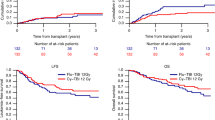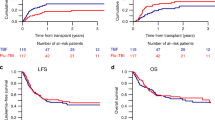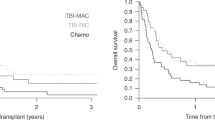Abstract
Patients with primary metastatic or recurrent rhabdomyosarcoma (RMS) have a very poor prognosis. Since high-dose chemotherapy (HDC) ± TBI was thought to improve survival, many centers performed this therapy using different types of hematopoietic rescue (auto BM or PBSC, allo BM). This is a retrospective, multicenter analysis of the results of treatment in 36 patients with primary metastatic or relapsed RMS who were given HDC ± TBI and hematopoietic rescue between 1986 and 1994. The median age was 6 years (<1–22 years). primary therapy was given according to either one of the cooperative german soft tissue sarcoma studies cws-81, -86, -91 or the european study for stage iv malignant mesenchymal tumors in childhood. there were 22 alveolar rms, 13 embryonal rms and one undifferentiated sarcoma. the indication for hdc was primary metastatic disease (27 patients) or a relapse of a primary localized tumor (nine patients). thirty-two patients were in 1st or 2nd cr when given hdc and four in vgpr. the median time from last event to hdc was 44 weeks (21–110). hdc consisted of fractionated melphalan ((4 × 30–45 mg/m2), VP16 40–60 mg/kg, carboplatin 3 × 400–500 mg/m2) in 26 patients, 10 of whom received additional FTBI. Seven patients were treated with melphalan alone or in combination with carboplatin. Two patients received cyclophosphamide/busulphan with TLI (total lymphoid irradiation) and one cyclophosphamide with FTBI. Thirty-one patients were given autologous BM or PBSC as hematopoietic rescue and five allogeneic bone marrow from HLA-identical siblings. Fourteen patients received GM-CSF or G-CSF after hematopoietic stem cell transfusion (HSCT). Ten patients received adjuvant IL-2. There was one toxic HDC-related death. Nine patients are alive and free of disease with a median observation time of 57 months (32–108). The median time from HDC to relapse was 4 months (1–17). The tumor recurred in the majority of patients at previously known sites; in three cases new metastatic sites were observed. Patients with primary localized tumors who had been treated with HDC because of relapse did slightly better (four of nine alive with NED) than patients with primary metastatic disease (five of 27 alive with NED). HDC is still of uncertain value in the therapy of poor-risk rhabdomyosarcoma and should be performed only as part of controlled clinical trials.
This is a preview of subscription content, access via your institution
Access options
Subscribe to this journal
Receive 12 print issues and online access
$259.00 per year
only $21.58 per issue
Buy this article
- Purchase on Springer Link
- Instant access to full article PDF
Prices may be subject to local taxes which are calculated during checkout
Similar content being viewed by others
Author information
Authors and Affiliations
Rights and permissions
About this article
Cite this article
Koscielniak, E., Klingebiel, T., Peters, C. et al. Do patients with metastatic and recurrent rhabdomyosarcoma benefit from high-dose therapy with hematopoietic rescue? Report of the German/Austrian Pediatric Bone Marrow Transplantation Group.. Bone Marrow Transplant 19, 227–231 (1997). https://doi.org/10.1038/sj.bmt.1700628
Received:
Accepted:
Issue Date:
DOI: https://doi.org/10.1038/sj.bmt.1700628
Keywords
This article is cited by
-
Clinicopathological characteristics and treatment outcomes of Chinese patients with genitourinary embryonal rhabdomyosarcoma
World Journal of Surgical Oncology (2015)
-
Allogeneic stem cell transplantation for patients with advanced rhabdomyosarcoma: a retrospective assessment
British Journal of Cancer (2013)
-
Soft Tissue Sarcomas in Children
The Indian Journal of Pediatrics (2012)
-
Banking on cord blood stem cells
Nature Reviews Cancer (2008)
-
Banking on cord blood stem cells
Nature Reviews Cancer (2008)



